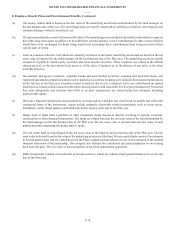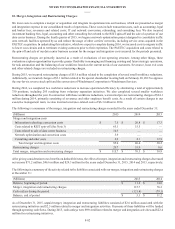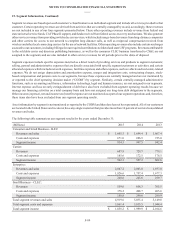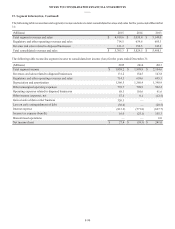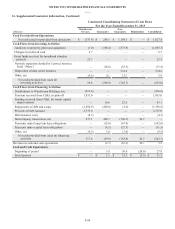Windstream 2015 Annual Report Download - page 216
Download and view the complete annual report
Please find page 216 of the 2015 Windstream annual report below. You can navigate through the pages in the report by either clicking on the pages listed below, or by using the keyword search tool below to find specific information within the annual report.
NOTES TO CONSOLIDATED FINANCIAL STATEMENTS
____
F-86
13. Income Taxes, Continued:
At December 31, 2015 and 2014, we had state net operating loss carryforwards of approximately $1,802.4 million and $1,990.6
million, respectively, which expire annually in varying amounts from 2016 through 2035. The loss carryforwards at December 31,
2015 were primarily losses acquired in conjunction with our prior acquisitions including PAETEC. The 2015 decrease is primarily
associated with the amount lost due to legal entity restructuring during the year. Federal and state tax rules limit the deductibility
of loss carryforwards in years following an ownership change. As a result of these limitations or the expected lack of sufficient
future taxable income, we believe that it is more likely than not that the benefit from certain federal and state loss carryforwards
will not be realized prior to their expiration. In September 2015, Windstream’s board of directors adopted a shareholder rights
plan designed to protect our net operating loss carryforwards from the effect of limitations imposed by federal and state tax rules
following an ownership change. This plan was designed to deter an ownership change (as defined in IRC Section 382) from
occurring, and therefore protect our ability to utilize our federal and state net operating loss carry forwards in the future. The plan
is not meant to be an anti-takeover measure and our board of directors has established a procedure to consider requests to exempt
the acquisition of Windstream common stock from the rights plan, if such acquisition would not limit or impair the availability
of our net operating loss carryforwards.
We establish valuation allowances when necessary to reduce deferred tax assets to amounts expected to be realized. Therefore, as
of December 31, 2015 and 2014, we recorded valuation allowances of $140.9 million and $94.9 million, respectively, related to
federal and state loss carryforwards which are expected to expire before they are utilized. The amount of federal tax credit
carryforward at December 31, 2015 and 2014, was approximately $46.1 million and $34.6 million, respectively, which expire in
varying amounts from 2031 through 2035. The amount of state tax credit carryforward at December 31, 2015 and 2014, was
approximately $24.4 million and $24.1 million, respectively, which expire in varying amounts from 2016 through 2027. Due to
legal entity restructuring during the year and the expected lack of sufficient future taxable income, we believe that it is more likely
than not that the benefit from some of the state tax credit carryforwards will not be realized prior to their expiration. Therefore,
as of December 31, 2015, we recorded a valuation allowance of approximately $7.0 million, net of federal benefit, to reduce
deferred tax assets to amounts expected to be realized.
We account for uncertainty in taxes in accordance with authoritative guidance. A reconciliation of the unrecognized tax benefits
is as follows:
(Millions) 2015 2014 2013
Beginning balance $ 5.6 $ 4.6 $ 18.3
Additions based on tax positions related to current year 5.0 2.3 2.7
Additions based on tax positions of prior years — — 0.7
Reductions for tax positions of prior years (0.5)(0.1)(0.2)
Reduction as a result of a lapse of the applicable statute of
limitations —(0.2)(16.9)
Settlements —(1.0) —
Ending balance $ 10.1 $ 5.6 $ 4.6
We do not expect or anticipate a significant increase or decrease over the next twelve months in the unrecognized tax benefits
reported above. The total amount of unrecognized tax benefits that, if recognized, would affect the effective tax rate are $9.9
million, $5.0 million and $3.4 million (net of indirect benefits) for the years ended December 31, 2015, 2014 and 2013, respectively.
Included in the balance at December 31, 2014 and 2013, are $0.6 million of gross tax positions for which the ultimate deductibility
is highly certain but for which there is uncertainty about the timing of such deductibility. No such amounts existed at December
31, 2015. Because of the impact of the deferred tax accounting, other than interest and penalties, the disallowance of the shorter
deductibility period would not affect the annual effective tax rate but would accelerate the payment of cash to the taxing authority
to an earlier period. These unrecognized tax benefits are included in other long-term liabilities in the accompanying consolidated
balance sheets for the years ended December 31, 2015 and 2014.
We file income tax returns in the U.S. federal jurisdiction and various states. With few exceptions, we are no longer subject to
U.S. federal, state and local income tax examinations by tax authorities for years prior to 2012. However, due to acquired net
operating losses, tax authorities have the ability to adjust those net operating losses related to closed years. We have identified
Arkansas, California, Florida, Georgia, Illinois, Iowa, Kentucky, Nebraska, New York, North Carolina, Pennsylvania, Texas and
Virginia as “major” state taxing jurisdictions.




